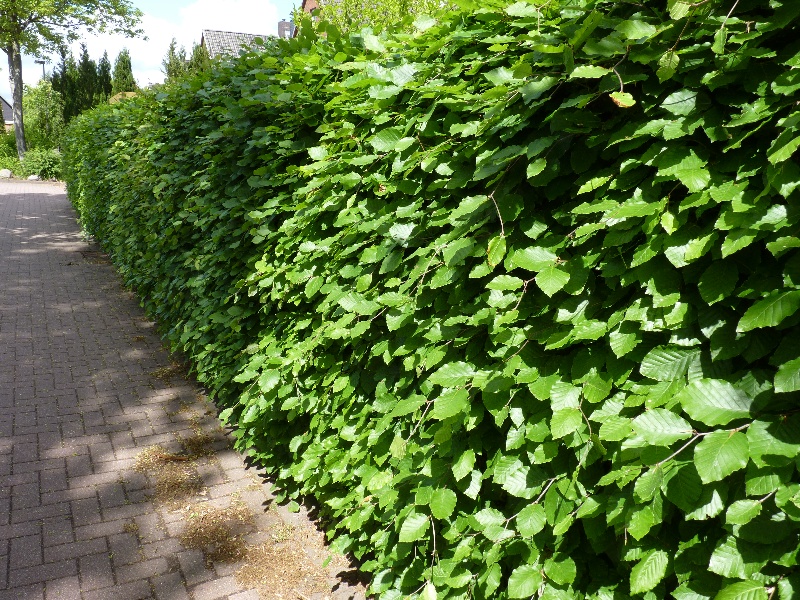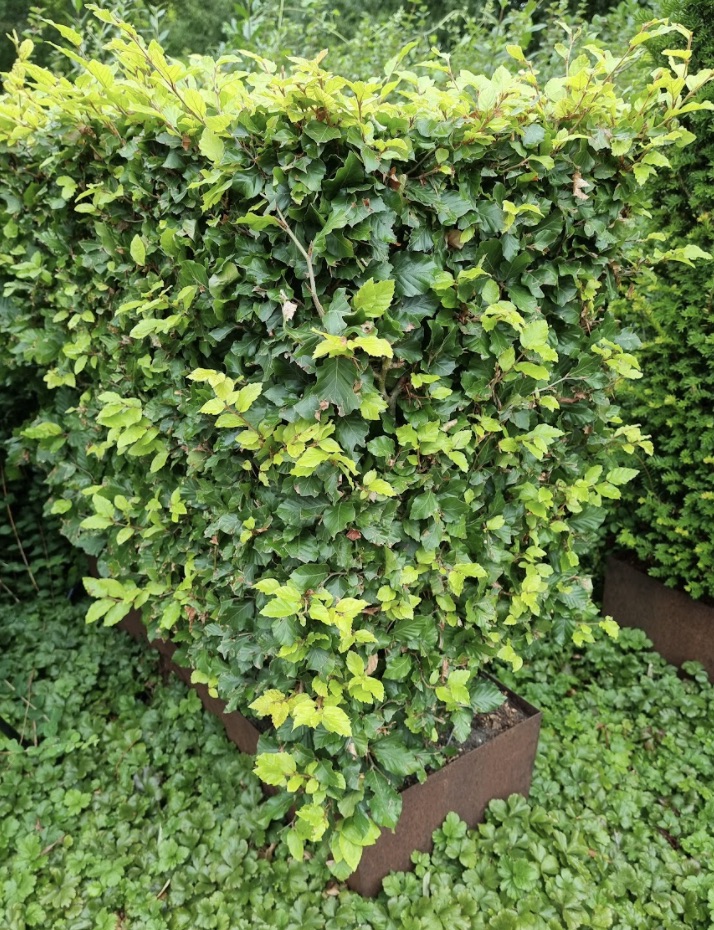
Fagus sylvatica Rotbuche, Rotbuchenhecke sehr schmal geschnitten
Fagus. Genus description. Fagus are large deciduous trees with smooth grey bark, ovate leaves colouring well in autumn, and inconspicuous flowers followed by usually spiny fruits. Name status. Correct

Garten Garten & Balkonpflanzen Hecken & Sträucher Fagus sylvatica 10 Stk Garten von Ehren
BBC Gardeners' World Magazine Published: Friday, 8 October 2021 at 11:10 am All you need to know about growing beech trees and hedging, in our Grow Guide. Common beech ( Fagus sylvatica) is one of the most majestic of European native trees, yet also makes an excellent formal hedge as it tolerates regular clipping.

Grüne Buchenhecke kaufen Fagus sylvatica Buche, Heckenpflanze
Fagus sylvatica, the European beech or common beech is a large, graceful deciduous tree in the beech family with smooth silvery-gray bark, large leaf area, and a short trunk with low branches. [3] Description Copper beech in autumn Shoot with nut cupules

Rotbuche; Fagus sylvatica; Grünblättrige Heckenpflanze; 6080 cm hoch Artländer Pflanzenhof
This account presents information on all aspects of the biology of Fagus sylvatica L. that are relevant to understanding its ecological characteristics and behaviour.The main topics are presented within the standard framework of the Biological Flora of the British Isles: distribution, habitat, communities, responses to biotic factors, responses to environment, structure and physiology.

Rotbuche Fagus sylvatica 150175 cm
Beech Botanical name: Fagus Beeches make large, handsome trees when fully grown, noted for their rich yellow or orange autumn colour. A number of narrow or weeping selections are suitable for gardens. Beech is often used for hedging and, although not evergreen, will retain old brown leaves in winter that provide additional interest and screening.

Kaufen Sie jetzt Heckenpflanze 6x Buchenhecke Fagus sylvatica Wurzelnackte Pflanzen
Rotbuche (Fagus Sylvatica)/ European Beech . The Rotbuche (Fagus Sylvatica) grows relatively fast, at a rate of 40-60cm a year. It is therefore important to trim this plant every year in early autumn or late spring. Generally, the European beech should be pruned in spring. Growing the European Beech. The European beech is suitable for a formal.

Grüne Buchenhecke kaufen Fagus sylvatica Buche, Heckenpflanze
Native to Central and Southern Europe, Fagus sylvatica (European Beech) is a beautiful, large, deciduous tree with a densely pyramidal to rounded-spreading crown. Its foliage of broadly elliptic, lustrous leaves (4 in. long or 10 cm), is pale green when young, dark green when mature, and turns rich russet and golden brown colors in the fall.

Blutbuche Fagus sylvatica Atropunicea 175200 cm, Wurzelballen
Copper beech, also known as purple beech, is a cultivated form of common beech (although copper-coloured beech trees are also sometimes found in nature). It grows to a height of more than 40m. The bark is smooth, thin and grey, often with slight horizontal etchings. Twigs are slender and grey but not straight - their shape resembles a zig-zag.

Kaufen Sie jetzt Heckenpflanze Buchenhecke Fagus sylvatica 'Atropururea‘ rot Winterhart kaufen
European beech is a strikingly beautiful tree native to Europe, which has been planted widely in New England. Its leaves turn reddish-coppery bronze in fall, and tend to persist (as most beech leaves do) throughout the winter. Its low-slung branches often droop to the ground. Its bark is smooth, gray, and the trunk resembles an elephant's foot.

Rotbuche Fagus sylvatica 100125 cm Kundenbewertung 5/5
Fagus sylvatica var. heterophylla 'Aspleniifolia' The RHS Award of Garden Merit (AGM) helps gardeners choose the best plants for their garden. RHS Plants for Pollinators plants. This plant will provide nectar and pollen for bees and the many other types of pollinating insects.

Fagus Sylvatica' Atropunicea' Heckenpflanze Blutbuche für eine Hecke eBay
European beech Family: Fagaceae Other common names: ahu (Albanian), fhaya (Asturian), Sometimes known as the 'queen of British trees', the European beech is one of the most common trees in parks, forests and woodlands across Britain.

Rotbuche Fagus sylvatica 175200 cm
Detaillierte Informationen Rot-Buche / Fagus sylvatica. Die laubabwerfende Heckenpflanze Fagus sylvatica,auch Rotbuche genannt, gehört zu den vier am häufigsten aufzufindenden Laubbäumen in den deutschen Wäldern. Sie kann ein Alter bis zu 300 Jahren erreichen. Rotbuchen sind ebenso in den deutschen Gärten sehr beliebt.

Kaufen Sie jetzt Heckenpflanze Buchenhecke Fagus sylvatica 'Atropururea‘ rot Winterhart kaufen
Herkunft. Die Rotbuche (Fagus sylvatica) aus der Familie der Buchengewächse (Fagaceae), umgangssprachlich kurz Buche genannt, ist überall in Europa heimisch, wo das Klima überwiegend feucht und kühl ist. Sie prägt hierzulande als häufigster Laubbaum das Bild der Wälder. Man findet sie vom Tiefland bis in die Alpen (bis in Höhen von 1.600 Meter).

Rotbuche, Fagus sylvatica, Fagus sylvatica Hecke kaufen Bauer Baumschulen AG
Soil. The European beech, Fagus sylvatica, is a large deciduous tree that can reach 40 metres tall when fully grown. In gardens, beech is a popular plant for hedging and pleaching. In autumn, the glossy green leaves turn beautiful shades of yellow and orange. Like hornbeam, beech has marcescent leaves i.e. dead leaves that are held on the plant.

Rotbuche Fagus sylvatica 6080 cm, Wurzelware
The better known Fagus subgenus beeches are high-branching with tall, stout trunks and smooth silver-grey bark. The European beech (Fagus sylvatica) is the most commonly cultivated. The European species Fagus sylvatica yields a utility timber used for furniture construction, flooring and engineering purposes, in plywood, and household items.

Blutbuche Fagus sylvatica Atropunicea 150175 cm, Wurzelballen
Als Heckenpflanzen kommen die grünblättrige Ursprungsart Fagus sylvatica sowie die rotlaubige Blutbuche (Fagus sylvatica f. purpurea) infrage. Beide sind robust, absolut winterhart und auch im Winter blickdicht, da die trockenen Blätter bis zum Austrieb der neuen Blätter im Frühjahr an den Pflanzen bleiben.